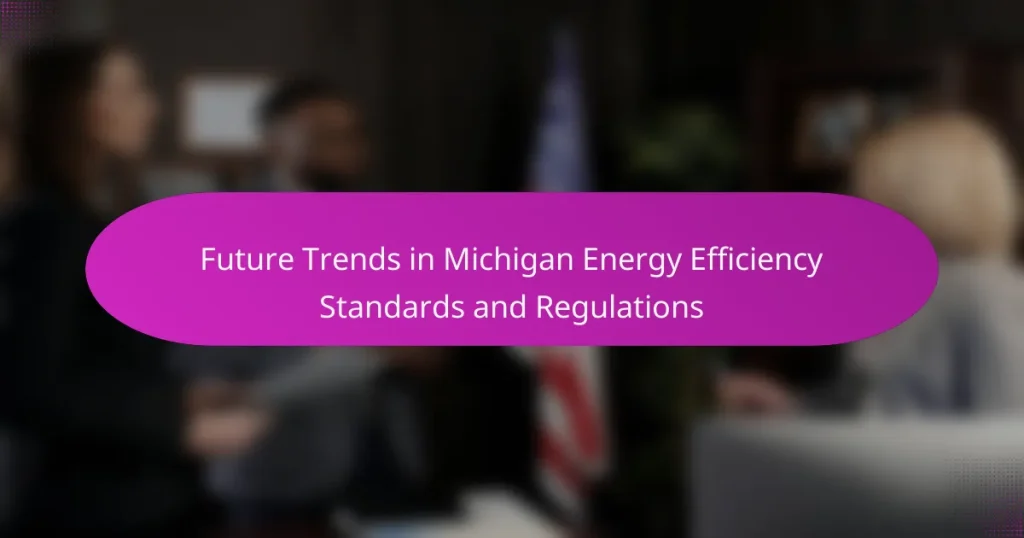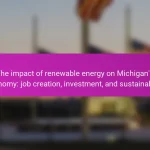
What are the Future Trends in Michigan Energy Efficiency Standards and Regulations?
Future trends in Michigan energy efficiency standards and regulations focus on stricter energy codes and enhanced utility programs. The state aims to align with national energy efficiency goals. New building codes will likely incorporate advanced energy-saving technologies. Regulations may emphasize renewable energy integration and carbon reduction targets. Utility companies are expected to increase investment in energy efficiency programs. These programs will target residential, commercial, and industrial sectors. The Michigan Public Service Commission is likely to play a crucial role in these developments. Recent legislation supports funding for energy efficiency initiatives, signaling a shift towards sustainable practices.
How are current energy efficiency standards evolving in Michigan?
Current energy efficiency standards in Michigan are evolving through updated legislation and increased regulatory measures. The state has implemented the Clean and Renewable Energy Act, which mandates specific efficiency goals for utilities. These goals require utilities to achieve energy savings of at least 1% of their total retail electricity sales annually. Additionally, Michigan’s Public Service Commission is enhancing energy efficiency programs to address residential and commercial sectors. Recent initiatives also focus on integrating advanced technologies, such as smart meters and energy management systems, to optimize energy use. These changes are supported by ongoing assessments of energy performance metrics and stakeholder engagement.
What factors are driving changes in energy efficiency regulations?
Changes in energy efficiency regulations are driven by technological advancements, economic incentives, and environmental concerns. Technological advancements improve energy-saving technologies, making them more accessible and effective. Economic incentives, such as tax credits and rebates, encourage businesses and consumers to adopt energy-efficient practices. Environmental concerns, including climate change, push governments to implement stricter regulations to reduce greenhouse gas emissions. For instance, the U.S. Department of Energy has set targets for energy efficiency improvements across various sectors. These factors collectively shape the evolving landscape of energy efficiency regulations.
How do these changes impact consumers and businesses?
Changes in Michigan’s energy efficiency standards impact consumers by reducing energy costs and improving home comfort. Consumers benefit from lower utility bills due to enhanced energy-saving measures. Businesses experience increased operational efficiency through reduced energy consumption. These changes can lead to lower overhead costs for businesses, enhancing profitability. Additionally, consumers may receive rebates and incentives for adopting energy-efficient technologies. This encourages investment in energy-efficient appliances and systems. Overall, the changes promote a more sustainable energy landscape, benefiting both consumers and businesses economically and environmentally.
What role does technology play in shaping energy efficiency standards?
Technology plays a crucial role in shaping energy efficiency standards. It enables the development of advanced measurement tools and data analytics. These innovations allow for precise monitoring of energy consumption. Enhanced technologies also facilitate the creation of more efficient appliances and systems. For instance, smart thermostats optimize energy use in real-time. Additionally, technology supports regulatory compliance through automated reporting systems. According to the U.S. Department of Energy, improved technology can lead to a 30% reduction in energy consumption. These advancements ensure that energy efficiency standards evolve to meet current demands.
How are advancements in technology influencing energy consumption?
Advancements in technology are significantly influencing energy consumption by increasing efficiency and enabling smarter energy management. Smart grids integrate digital technology, allowing for real-time monitoring and optimization of energy use. Energy-efficient appliances consume less power, reducing overall consumption in households and businesses. Renewable energy technologies, such as solar panels, provide cleaner energy sources and decrease reliance on fossil fuels. According to the U.S. Department of Energy, energy-efficient technologies can reduce energy consumption by up to 30% in residential and commercial sectors. Additionally, data analytics and artificial intelligence enhance energy forecasting and demand response strategies, further optimizing usage. These technological advancements contribute to lower energy costs and a reduced carbon footprint.
What innovative solutions are being implemented in Michigan?
Michigan is implementing innovative solutions focused on energy efficiency and sustainability. The state has introduced advanced energy efficiency programs targeting residential and commercial sectors. These programs aim to reduce energy consumption and promote renewable energy sources. For example, Michigan’s Clean Energy Plan encourages the adoption of solar energy and energy storage systems. The state also supports electric vehicle infrastructure to reduce carbon emissions. Additionally, smart grid technology is being deployed to enhance energy management. These initiatives are backed by legislation promoting energy efficiency standards. As a result, Michigan is positioning itself as a leader in sustainable energy practices.

What are the implications of these trends for stakeholders?
The implications of future trends in Michigan energy efficiency standards and regulations for stakeholders include increased compliance costs and opportunities for innovation. Stakeholders such as businesses may face higher expenses to meet new standards. These costs could impact profit margins and pricing strategies. However, stricter regulations can drive innovation in energy-efficient technologies. Stakeholders may also benefit from incentives for adopting sustainable practices. Enhanced efficiency standards can lead to long-term savings on energy bills. Additionally, consumers might see improved product offerings and lower energy costs. Overall, stakeholders must adapt to these trends to remain competitive and sustainable.
How do new regulations affect utility companies in Michigan?
New regulations significantly impact utility companies in Michigan by mandating stricter energy efficiency standards. These regulations require utilities to invest in renewable energy sources and improve infrastructure. Compliance with these standards can lead to increased operational costs for utility companies. However, they also promote long-term savings through reduced energy consumption. For instance, the Michigan Public Service Commission has set targets for energy savings that utilities must meet. This shift encourages innovation in energy management practices. Additionally, utilities may face penalties for non-compliance, further incentivizing adherence to the new regulations. Overall, these changes aim to enhance sustainability in Michigan’s energy landscape.
What compliance challenges do utility companies face?
Utility companies face several compliance challenges, primarily related to regulatory changes and environmental standards. These companies must adapt to evolving state and federal regulations on emissions and energy efficiency. Additionally, they encounter difficulties in meeting renewable energy targets set by legislation. The complexity of compliance requirements can strain resources and lead to increased operational costs. Utility companies also grapple with the need for accurate reporting and data management to demonstrate compliance. Failure to meet these standards can result in significant penalties and reputational damage. In Michigan, the emphasis on energy efficiency standards further complicates compliance efforts. Utility companies must stay informed and agile to navigate these challenges effectively.
How can utility companies adapt to new energy efficiency standards?
Utility companies can adapt to new energy efficiency standards by implementing advanced technologies. These technologies include smart meters and energy management systems. They allow for real-time monitoring and optimization of energy usage. Utility companies should also invest in renewable energy sources. This aligns with regulatory requirements and enhances sustainability.
Training programs for employees on new standards are essential. Educated staff can better implement and manage energy efficiency initiatives. Collaboration with regulatory bodies ensures compliance with evolving standards.
Data analytics can identify areas for improvement in energy consumption. This approach helps utilities optimize their operations and reduce waste. Research indicates that utilities that proactively adapt can improve customer satisfaction and reduce operational costs.
What are the potential benefits for consumers?
The potential benefits for consumers include reduced energy costs and improved energy efficiency. Consumers can save money on utility bills due to lower energy consumption. Enhanced energy efficiency standards can lead to better home comfort and air quality. Additionally, consumers may experience increased property values from energy-efficient upgrades. Access to incentives and rebates can further offset the costs of energy-efficient improvements. According to the U.S. Department of Energy, energy-efficient homes can save homeowners up to 30% on energy costs annually. Overall, these regulations can contribute to long-term financial savings and environmental benefits for consumers.
How can consumers save money through energy efficiency measures?
Consumers can save money through energy efficiency measures by reducing their energy consumption. Implementing energy-efficient appliances can lower utility bills significantly. For example, ENERGY STAR-rated products use 10-50% less energy than standard models. Proper insulation in homes minimizes heating and cooling costs. According to the U.S. Department of Energy, homeowners can save up to 20% on energy bills with adequate insulation. Additionally, using programmable thermostats helps optimize heating and cooling schedules, leading to further savings. Switching to LED lighting can also reduce electricity costs by up to 75% compared to incandescent bulbs. Overall, adopting these measures leads to substantial long-term financial benefits for consumers.
What incentives are available for consumers to improve energy efficiency?
Consumers can access various incentives to improve energy efficiency. These incentives include tax credits, rebates, and grants. Tax credits reduce the amount owed to the government based on energy-efficient upgrades. Rebates provide cash back for purchasing energy-efficient appliances or making home improvements. Grants offer direct financial aid for energy efficiency projects. Programs like the Michigan Energy Smart program provide additional resources for consumers. According to the U.S. Department of Energy, energy efficiency improvements can save homeowners up to 30% on energy bills. This financial benefit reinforces the importance of these incentives.

What are the challenges in implementing future energy efficiency standards?
Implementing future energy efficiency standards faces several challenges. One major challenge is the lack of consistent regulatory frameworks across jurisdictions. Different states may adopt varying standards, complicating compliance for businesses operating in multiple areas. Additionally, funding for energy efficiency programs can be insufficient. Many initiatives rely on financial incentives, which may not be consistently available.
Another challenge is the resistance from stakeholders, including manufacturers and consumers. These groups may oppose new standards due to perceived costs or changes in product availability. Furthermore, technical barriers exist, such as the need for advanced technologies that may not yet be commercially viable.
Lastly, there is often a knowledge gap regarding energy efficiency benefits. Many consumers and businesses may not fully understand the long-term savings associated with implementing these standards. This can lead to a lack of motivation to adopt new practices.
What barriers exist for businesses in adopting new regulations?
Businesses face several barriers in adopting new regulations. These barriers include high compliance costs, lack of understanding, and resistance to change. High compliance costs can strain resources, especially for small businesses. Lack of understanding of the regulations can lead to improper implementation. Resistance to change often stems from established practices and fear of disruption. Additionally, limited access to information and support can hinder adaptation. According to a survey by the National Federation of Independent Business, 60% of small businesses cite regulatory burdens as a significant concern. This data underscores the challenges businesses encounter in navigating new regulatory landscapes.
How does the cost of compliance affect small businesses?
The cost of compliance significantly impacts small businesses by increasing operational expenses. Small businesses often operate with limited budgets. Compliance costs can divert funds from growth and innovation. In Michigan, small businesses face specific energy efficiency regulations. These regulations can lead to higher utility costs and investment in upgrades. According to the U.S. Small Business Administration, small businesses spend approximately $83 billion annually on compliance. This financial burden can hinder competitiveness and profitability. Additionally, non-compliance can result in fines, further straining resources. Therefore, the cost of compliance is a critical concern for small businesses in Michigan.
What strategies can businesses use to overcome these challenges?
Businesses can employ multiple strategies to overcome challenges related to Michigan’s energy efficiency standards. First, they can invest in employee training programs. Educated employees can better implement energy-efficient practices. Second, businesses can adopt advanced technologies. Smart systems and energy management software can optimize energy use. Third, they can collaborate with local energy providers. Partnerships can provide incentives and resources for compliance. Fourth, businesses should conduct regular energy audits. Audits identify areas for improvement and help track progress. Finally, they can engage in community initiatives. Participation in local sustainability programs can enhance public perception and drive customer loyalty. These strategies collectively help businesses navigate and thrive amid evolving energy regulations.
How can policymakers support effective energy efficiency standards?
Policymakers can support effective energy efficiency standards by establishing clear regulations and incentives. They should create stringent guidelines that set measurable efficiency targets for various sectors. Financial incentives, such as tax credits or rebates, can encourage businesses and homeowners to adopt energy-efficient technologies. Additionally, policymakers can invest in public awareness campaigns to educate the community about the benefits of energy efficiency. Collaboration with industry stakeholders can also help in developing practical and achievable standards. Research shows that states with strong energy efficiency policies can reduce energy consumption significantly. For instance, a study by the American Council for an Energy-Efficient Economy found that states with robust efficiency programs saved an average of 1.2% of annual electricity sales. This evidence highlights the effectiveness of supportive policies in driving energy efficiency.
What role does public awareness play in energy efficiency initiatives?
Public awareness is crucial for the success of energy efficiency initiatives. It drives community engagement and fosters support for energy-saving programs. Increased awareness leads to better understanding of energy consumption impacts. This understanding motivates individuals and organizations to adopt energy-efficient practices. Studies show that informed consumers are more likely to participate in efficiency programs. For instance, the American Council for an Energy-Efficient Economy reported that awareness campaigns can increase participation by up to 25%. Public awareness also influences policy decisions by demonstrating demand for energy efficiency. Ultimately, it creates a culture of sustainability and responsibility in energy use.
How can collaboration among stakeholders enhance regulatory effectiveness?
Collaboration among stakeholders enhances regulatory effectiveness by fostering shared knowledge and resources. Engaging various parties, such as government agencies, industry representatives, and community groups, leads to a comprehensive understanding of regulatory challenges. This collective input can identify practical solutions that address diverse perspectives. For example, in Michigan’s energy sector, collaboration has resulted in more tailored energy efficiency standards. Studies indicate that states with stakeholder engagement see improved compliance rates and innovation in regulatory practices. Effective collaboration can also streamline communication, reducing misunderstandings and delays in implementation.
What practical steps can individuals take to enhance energy efficiency?
Individuals can enhance energy efficiency by implementing several practical steps. First, they should replace incandescent bulbs with LED lighting. LED bulbs use up to 75% less energy. Second, individuals can seal windows and doors to prevent drafts. This reduces heating and cooling costs significantly. Third, using energy-efficient appliances is crucial. Energy Star-rated appliances consume less electricity. Fourth, individuals should consider smart thermostats. These devices optimize heating and cooling schedules. Fifth, adopting energy-saving habits, like unplugging devices when not in use, can help. This simple action reduces phantom energy consumption. Lastly, individuals can conduct energy audits. These audits identify areas for improvement in energy use. Implementing these steps can lead to substantial energy savings and lower utility bills.
The main entity of the article is Michigan’s energy efficiency standards and regulations. The article outlines future trends that include stricter energy codes, enhanced utility programs, and a focus on renewable energy integration and carbon reduction. It discusses the evolution of current standards driven by technological advancements, economic incentives, and environmental concerns, along with their implications for consumers and businesses. Additionally, the article highlights the challenges faced by utility companies in compliance and the importance of collaboration among stakeholders to enhance regulatory effectiveness. Key strategies for consumers and businesses to adapt to these changes are also presented.


